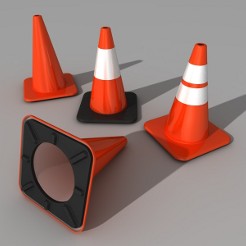 Traffic control devices are used by businesses to maintain safe traffic patterns within their facilities, as well as at entrances and exits. They can be used to increase security, reduce accidents and promote driver safety.
Traffic control devices are used by businesses to maintain safe traffic patterns within their facilities, as well as at entrances and exits. They can be used to increase security, reduce accidents and promote driver safety.
Many business install speed bumps, orange traffic cones, speed limit signs and other traffic control devices can help remind drivers to drive safely and to control the flow of traffic into, out of, and within their facilities.
But some traffic control devices are more effective than others at inhibiting poor driving decisions. And some are most cost-effective to implement.
Government Study Provides Relevant Lessons
The effectiveness of different types of traffic control devices was examined in a groundbreaking study conducted in the 1980s by the US Department of Transportation’s Federal Highway Administration, called “State of the Art Report: Residential Traffic Management”. The report, which is still used by urban planners and industrial design teams to create and maintain safe and affordable traffic patterns, looked at the effectiveness of various types of traffic control devices to determine which ones worked best and which were a waste of money and effort.
The report’s findings, though more than 30 years old, continue to have practical applications for today’s businesses, including:
- Placing transverse markings on the road surface was effective for reducing average speed of vehicles passing through the area and possibly reduced noise levels, but had no effect on traffic volume or directional control.
- Despite creating a psychological interest in drivers, posting speed limit signs with odd speeds (23 mph, 12 mph, etc,) had no effect on speed or volume reduction nor did they affect noise, safety or access by emergency vehicles. Furthermore,they were more prone to vandalism.
- Installing crosswalks had some positive influence on speed reduction, but were ineffective at improving safety.
Physical Barriers vs. Passive Controls
More effective were such physical controls as speed bumps, rumble strips, and building cul-de-sacs, traffic circles and median barriers. These type of physical controls were generally more effective than passive controls such as stop signs, speed limit signs, “No Turn” signs and one-way traffic signs which drivers could ignore if they chose.
The lesson appears to be that creating physical barriers to control traffic — such as speed bumps, drum barricades and traffic cones — are more effective at promoting driver safety than using passive controls like traffic signs or psychological traffic control devices such as painting the road surface with crosswalks or traverse markings.
Permanent Devices vs. Portable
Another consideration is whether to install permanent structures — such as cement or asphalt speed bumps — or temporary structures that can be installed, replaced or moved at will. While permanent structures may provide more durability and less maintenance, they can be expensive to remove and repair should traffic patterns shift or business owners reconfigure the traffic flow of their facilities.
Temporary, lightweight speed bumps made of high impact plastic offer both the versatility to be moved wherever and whenever they are needed and more affordability.
Sometimes Simpler Is Better
Similarly, simple orange parking cones can be an effective way to provide a physical and psychological barrier to traffic and to control traffic patterns without the long term construction costs and permanence of installing guardrails, curbs, permanent barriers or other more expensive traffic safety devices.
If you are looking for affordable, flexible solutions to your company’s traffic safety problems, look no farther than Barhns. We carry a complete inventory of all the latest traffic safety devices that you can use to configure traffic patterns within your facility any way you choose.
